In the rich tapestry of Norse mythology, where gods and giants stride across the realms weaving tales of power, magic, and intrigue, there lies a figure shrouded in mystery and often overlooked: Angrboða. Known as the fierce giantess and the mother of monsters, her story is one that challenges the depths of our understanding of Norse lore. Angrboða’s enigmatic nature and her significant, albeit less discussed, role within the ancient texts open a gateway to exploring the complex interweaving of fate, magic, and power that defines the Norse cosmological narrative.
This introduction invites you to delve into the shadowy corners of Norse myths, to uncover the story of Angrboða, a figure who, despite her critical contributions to the sagas, remains on the fringes of mainstream discussions. As we peel back the layers of her legend, we find not just a mother of some of the most fearsome entities but also a symbol of strength, resilience, and the unfathomable depths of the old Norse world. Join us as we journey through the Iron Wood to meet Angrboða, whose tale is as compelling as it is complex.

Table of Contents
Angrboða’s Identity and Origins
The Meaning Behind the Name
Delving into the etymology of ‘Angrboða‘ sheds light on her daunting presence within Norse mythology. Her name, when broken down, resonates with the ominous titles of “Bringer of Grief” or “Herald of Sorrow,” hinting at the profound impact her lineage would have on the cosmos. This nomenclature not only encapsulates her essence as a formidable figure but also subtly foreshadows the pivotal roles her offspring play in the Norse mythological saga, particularly in the events leading up to Ragnarok.
Angrboða in Old Norse Texts
The ancient manuscripts of the Poetic Edda and Prose Edda serve as the primary windows into the Norse mythological world, offering fragmented glimpses of Angrboða’s character. Despite the scarcity of direct references, her presence is palpable through the lineage of her children with Loki: the monstrous wolf Fenrir, the Midgard Serpent Jörmungandr, and the enigmatic Hel, who presides over the realm of the dead.
These texts portray Angrboða not merely as a giantess or a witch but as a key progenitor within the Norse pantheon, whose offspring encapsulate the forces of chaos and destruction that are central to the cyclical nature of Norse cosmology.
The portrayal of Angrboða in these Old Norse texts is nuanced and multifaceted, suggesting a character of great power and mystery. While the Eddas provide but a whisper of her tale, they imbue her with a sense of mystique that has captivated the imagination of scholars and enthusiasts alike. In exploring the sparse yet evocative mentions of Angrboða in these ancient writings, we are invited to piece together the puzzle of her story, one that intertwines with the very fabric of Norse mythological narrative.
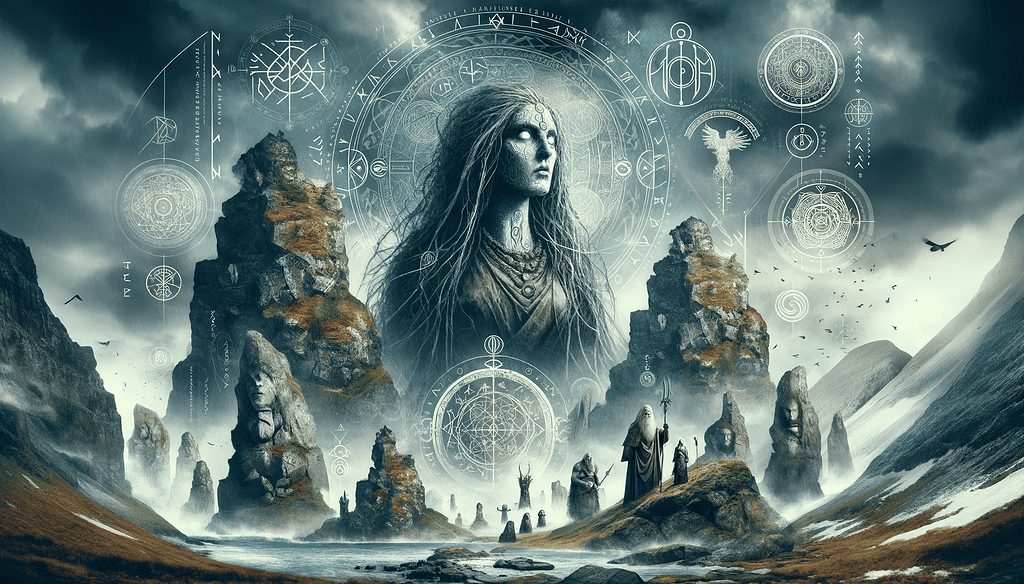
The Enigmatic Consort of Loki
Loki and Angrboða’s Relationship
The bond between Loki, the Norse god known for mischief and transformation, and Angrboða, the giantess from the Iron Wood, is one steeped in complexity and profound implications. Their union is not merely a coupling of two mythological figures but a confluence of chaos and foresight, birthing beings that would come to challenge the established order of the cosmos. This relationship underscores a theme central to Norse mythology: the intertwining of creation and destruction, where the birth of new entities often heralds the onset of profound changes.
Angrboða: Mother of Monsters
Angrboða’s legacy within Norse mythology is indelibly marked by her role as the mother of some of its most formidable and symbolic figures: Fenrir, the bound wolf destined to break free come Ragnarok; Jörmungandr, the World Serpent encircling Midgard; and Hel, ruler of the eponymous realm of the dead. Each of these offspring embodies fundamental aspects of the Norse universe’s cyclical nature, from the inevitability of death to the encroaching chaos that precedes renewal.
Angrboða’s motherhood to these entities is not just a biological fact but a testament to her significant, albeit understated, influence on the mythological narrative. Through her children, Angrboða weaves a thread of destiny that runs through the heart of the Norse cosmos, challenging gods and mortals alike to confront the intricate dance of fate, power, and the natural order.
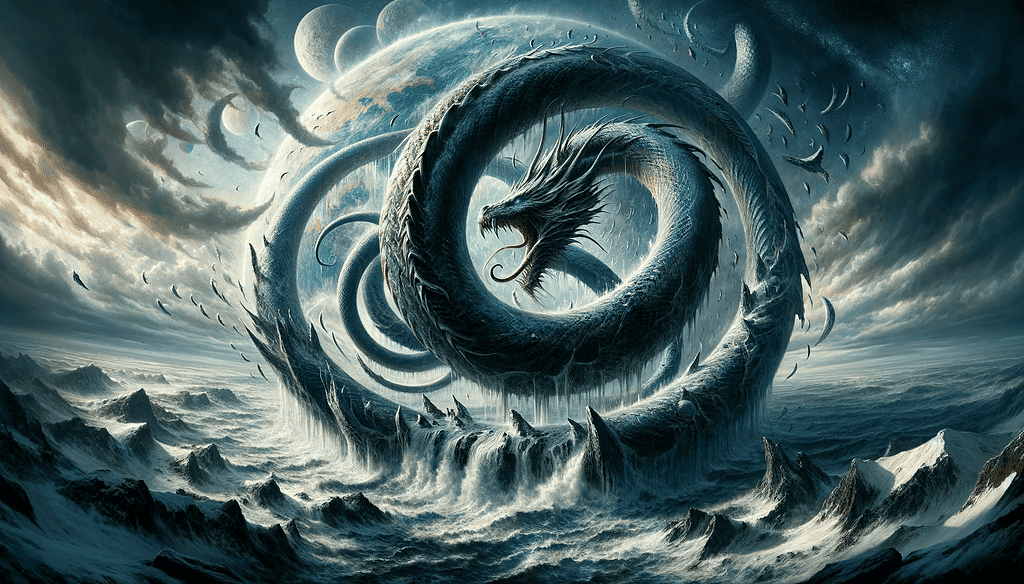
Contextual Notes:
Before delving into the family tree of Angrboða, it’s essential to understand the significance of lineage and prophecy within Norse mythology. Norse myths are rich with tales of gods, giants, and mythical creatures intertwined in complex relationships that shape the cosmos’s fate. Central to these narratives is Ragnarok, the prophesied apocalypse that marks the end and rebirth of the world.
Angrboða, often overshadowed in popular retellings, is crucial to this mythological framework. As the mother of some of the most formidable beings in these myths, her progeny are key players in the events leading to Ragnarok, making her lineage a focal point for understanding the inevitable cycle of destruction and renewal that defines Norse cosmology.
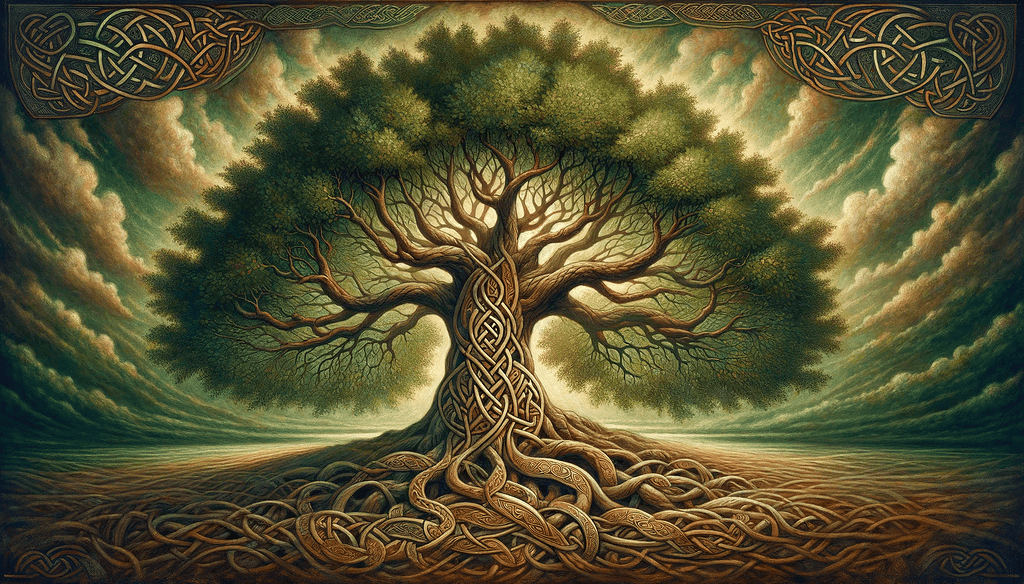
Family Tree of Angrboða – An Introductory Guide
| Relation | Name | Description | Role in Ragnarok | Symbolic Meaning |
|---|---|---|---|---|
| Consort | Loki | The Norse trickster god, known for his shapeshifting and mischievous antics. | Initiator of events leading to Ragnarok, including the release of Fenrir. | Represents chaos, change, and the complexity of morality. |
| Child | Fenrir | The giant wolf prophesied to play a crucial role during Ragnarok by battling and slaying Odin. | Destined to break free and kill Odin, the Allfather of the gods. | Symbolizes the power of nature and the inevitability of fate. |
| Child | Jörmungandr | The World Serpent that encircles Midgard (Earth), destined to fight Thor during Ragnarok. | Engages in a fatal battle with Thor, leading to both their deaths. | Embodies the cyclical nature of life and the encompassing boundaries of the world. |
| Child | Hel | The goddess of death who presides over the underworld realm of the same name, where she receives a portion of the dead. | Plays a role in hosting the dead who are not slain in battle, influencing the afterlife. | Represents death, transition, and the afterlife. |
| Grandchildren | (Various) | Depending on sources and interpretations, could include Fenrir’s children, Sköll and Hati, who chase the sun and moon. | Foretold to continue the cycle of cosmic events by pursuing celestial bodies. | Illustrate the perpetual struggle between light and darkness, order and chaos. |
The Mythological Tapestry of Angrboða’s Family
The family of Angrboða, a figure entwined deeply in the roots of Norse mythology, presents a fascinating study of divine and monstrous intertwines. As Loki’s consort, Angrboða stands at the confluence of chaos and creation, her lineage defining pivotal elements of the mythological narrative. Through her, we glimpse the Norse cosmos’s complexity, where gods and monsters share kinship, and destiny is as fickle as the trickster god Loki himself.
Angrboða and Loki: A Union of Chaos
The relationship between Angrboða, the giantess of Jotunheim, and Loki, the god of mischief, is emblematic of Norse mythology’s embrace of duality and contradiction. This partnership, marked by the birth of some of the most formidable beings in Norse lore, is a testament to the unpredictable nature of the divine. As Loki’s wife, Angrboða’s role transcends the conventional, her figure emblematic of the raw, untamed forces of nature that even the gods must reckon with.
Progeny of Power: Angrboða’s Monstrous Offspring
The children of Angrboða and Loki – Fenrir, the giant wolf; Jörmungandr, the Midgard Serpent; and Hel, the goddess of death – are central to the narrative arc leading to Ragnarok, the end of the world. Each child embodies a fundamental aspect of the cosmos’s cyclical destruction and rebirth, their fates intertwined with the gods and the ultimate destiny of the universe. These monstrous offspring stand as a testament to Angrboða’s significant role within the mythological framework, her brood heralding the great upheavals that define the end times.
Through the Lens of Snorri Sturluson
Snorri Sturluson, whose writings are among the primary sources for much of what is known about Norse mythology, offers a perspective on Angrboða that is both illuminating and limited. His portrayal of Angrboða and her family reflects the medieval Christian context in which he wrote, often casting her in the shadow of her children and Loki. Yet, even through this lens, the importance of Angrboða’s character and her contributions to the Norse mythos are undeniable, her presence woven into the stories that have captivated the imagination for centuries.
The Complex Character of Angrboða
Angrboða’s depiction as both a loving mother and a bringer of great misfortune encapsulates the multifaceted nature of her character. She is the mother of some of the most fearsome creatures in Norse mythology yet retains a deeply complex persona that defies simple categorization. Her story invites a deeper exploration of themes such as destiny, the intertwining of creation and destruction, and the nuanced portrayals of feminine power within ancient narratives.
The family of Angrboða, intricate and intertwined with the fate of the entire world, serves as a microcosm of Norse mythology’s broader themes. Through the saga of this formidable figure and her unusual children, we gain insight into the ancient Norse’s worldview, one where the lines between god, giant, and monster blur, giving rise to a fascinating world rich with stories and sagas that continue to resonate to this day.
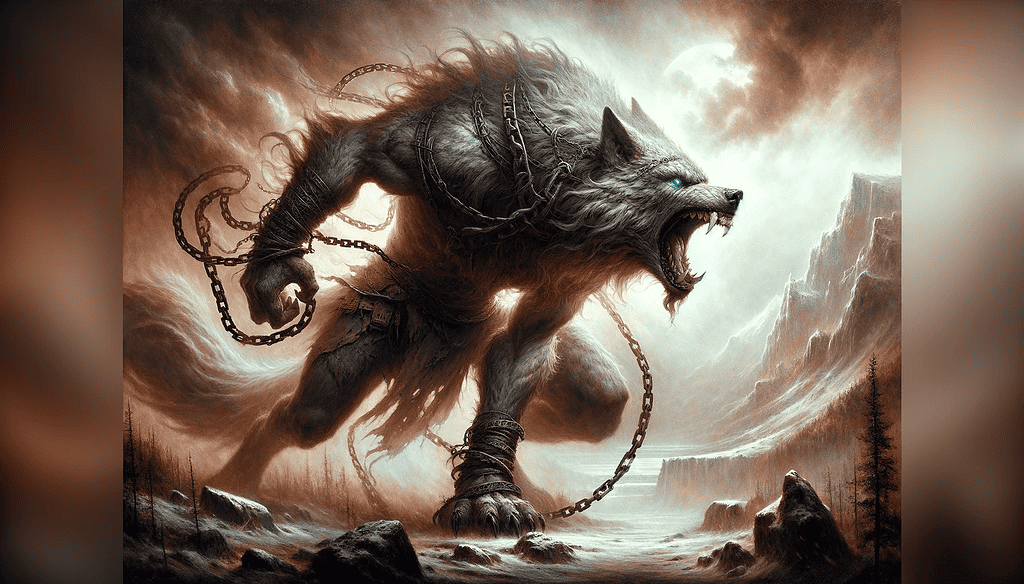
Angrboða’s Realm and Influence
Life in the Iron Wood
Nestled in the mysterious expanse east of Midgard, the Iron Wood is more than just the home of Angrboða; it is a realm that epitomizes the untamed and primal aspect of the Norse cosmos. This dense and shadowy forest, inhabited by giantesses and fearsome creatures, serves as a stark contrast to the order of Asgard and the civilizations of humans. Angrboða’s dominion here underscores her nature as a formidable figure and a wise woman deeply connected to the ancient forces that predate the Norse gods themselves. The Iron Wood, with its dark and wild beauty, stands as a symbol of the untamed power and mystery that Angrboða embodies.
Angrboða’s Impact on the Norse Sagas
Angrboða’s influence on the tapestry of Norse mythology is profound, with her actions and her brood of unusual children setting the stage for the cataclysmic events of Ragnarok. As the mother of Fenrir, the World Serpent, and Hel, she is central to the unfolding of these sagas, her offspring destined to play key roles in the end of the world.
Fenrir’s eventual freedom and the ensuing battle, Jörmungandr’s encircling grip on Midgard, and Hel’s dominion over the dead all weave into the fabric of Ragnarok, highlighting Angrboða’s significant role in these pivotal moments.
Her story and her children encapsulate the cyclical nature of existence within Norse beliefs—the inevitable end and rebirth of the world. Through Angrboða and her lineage, the Norse sagas explore themes of fate, chaos, and the balance between destruction and renewal, making her an influential figure whose impact resonates through the ages.

Angrboða’s Legacy and Modern Interpretations
From Ancient Myths to Modern Interpretations
Angrboða’s character has transcended the confines of ancient Norse literature, finding new life and meaning in the realms of modern paganism, literature, and popular culture. This transition from myth to modernity showcases her as a complex figure, one whose facets extend beyond the traditional narratives of darkness and destruction.
In contemporary portrayals, Angrboða is often seen as a symbol of strength, resilience, and the untamed forces of nature, resonating with those who seek a deeper connection to the earth and its ancient wisdom. Her story, rich in symbolism and power, has been reimagined in various forms, from novels and artworks to rituals and festivals, each interpretation adding layers to her already multifaceted character.
Reassessing Angrboða’s Role
The traditional image of Angrboða as a harbinger of doom and a mother of monsters is ripe for reassessment. Modern interpretations invite us to see her not just as a figure of fear but as a representation of nature’s indomitable will, a loving mother, and a wise woman deeply connected to the primal forces of the universe. This nuanced understanding challenges the one-dimensional portrayal of Angrboða, encouraging a broader appreciation of her role within Norse mythology and her significance as a powerful, influential figure.
By embracing these multifaceted interpretations, we can appreciate Angrboða not only as a central figure in the myths but also as a symbol of the cyclical nature of life, death, and rebirth, offering rich insights into the complexities of existence and the enduring wisdom of ancient lore.
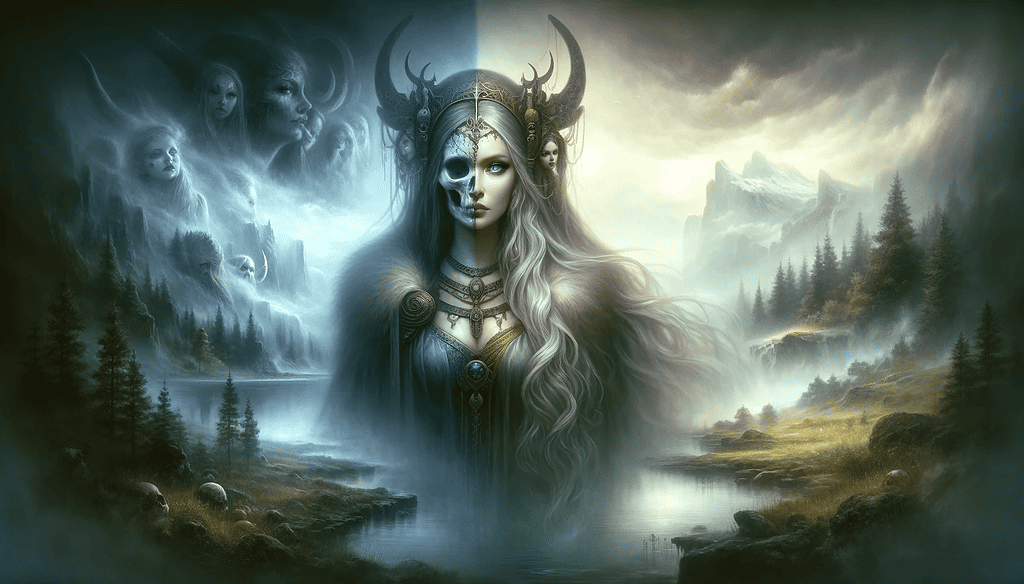
Unveiling Angrboða’s Legacy
Angrboða’s story, woven deeply into the fabric of Norse mythology, offers a rich tapestry of themes and narratives that resonate well beyond the ancient texts. Her legacy, as the giantess mother of some of the most pivotal figures in the mythos, bridges the worlds of gods, giants, and the forces of chaos and creation.
This exploration invites modern audiences, particularly those enchanted by Norse mythology and paganism, to delve deeper into Angrboða’s enigmatic character. It challenges us to consider the complexities of her role not just within the mythological framework but also in the context of what it means to be a powerful, influential figure amidst a pantheon of gods and monsters.
Engaging with Angrboða’s story is an invitation to uncover the layers of meaning in Norse lore, encouraging a nuanced appreciation of its characters and their enduring impact.
To further enrich the “Family Tree of Angrboða” table and make it an invaluable resource for beginners to Norse mythology, adding contextual notes and a glossary can provide essential background information and clarify key terms. Below are the suggested additions:
Glossary of Key Terms:
- Ragnarok: The foretold apocalypse in Norse mythology, involving a great battle that leads to the death of many gods, natural disasters, and the world’s subsequent rebirth.
- Midgard: One of the nine worlds in Norse cosmology, Midgard is the human realm, situated between the realm of the gods (Asgard) and the giants (Jotunheim).
- Allfather (Odin): The chief of the gods in Norse mythology, Odin is known as the Allfather for his role as the father of many gods and his wisdom and knowledge.
- Jotunheim: The realm of the giants in Norse mythology, often depicted as a land of wilderness and untamed nature, and home to Angrboða.
- Edda: Refers to two primary sources of Norse mythology: the Poetic Edda, a collection of Old Norse poems from the medieval manuscript Codex Regius, and the Prose Edda, a compilation of Norse myths written by Snorri Sturluson in the 13th century.
Check out these other categories:
